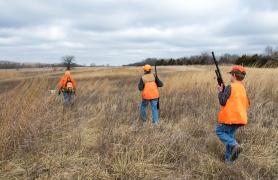Body
- Some oak trees hang on to their dead, brown leaves all winter long. In the spring, the growth of new leaves finally pushes the dead leaves off.
- When a great horned owl gets hungry, it will eat nearly anything — even other owls. Barred owls live in the same places as great horned owls, but when a great horned is nearby, barred owls usually fly away to avoid becoming dinner.
- Least shrews win the prize for being Missouri’s tiniest mammals. These 3-inchlong predators weigh about as much as a penny. Elk are Missouri’s largest mammals. Bull elk can tip the scales at more than 800 pounds!
- Devil crayfish are big-league burrowers. To reach underground water, the clawful crustaceans dig tunnels that can be more than 15 feet deep.
- Mourning doves — like many birds — eat bits of sand and gravel. The grit collects in the dove’s gizzard, a muscular part of the stomach. When food reaches the gizzard, the muscles squeeze tightly, and the grit grinds up seeds and other hard items.
- The boss bird in a flock of dark-eyed juncos feeds in the center where it’s safest. Juncos often lunge at each other and flick open their tails, which is how they decide who gets to be in charge.
- Chipmunks have cheek pouches that they pack like grocery sacks with seeds and nuts. To protect the pouches, ’munks use their sharp teeth to clip off pokey parts of acorns before cramming them inside.
Also In This Issue
Media

Body
A powerful ally, the forest is.
Media

Body
Bagging a bobwhite takes a smart dog, a patient grandpa, and lots of walking.
This Issue's Staff
Bonnie Chasteen
Les Fortenberry
Karen Hudson
Angie Daly Morfeld
Noppadol Paothong
Marci Porter
Mark Raithel
Laura Scheuler
Matt Seek
David Stonner
Nichole LeClair Terrill
Stephanie Thurber
Cliff White
Les Fortenberry
Karen Hudson
Angie Daly Morfeld
Noppadol Paothong
Marci Porter
Mark Raithel
Laura Scheuler
Matt Seek
David Stonner
Nichole LeClair Terrill
Stephanie Thurber
Cliff White






















